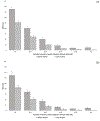Natural Walking Intensity in Persons With Parkinson Disease
- PMID: 37016469
- PMCID: PMC10330027
- DOI: 10.1097/NPT.0000000000000440
Natural Walking Intensity in Persons With Parkinson Disease
Abstract
Background and purpose: Few persons with Parkinson disease (PD) appear to engage in moderate-intensity walking associated with disease-modifying health benefits. How much time is spent walking at lower, yet still potentially beneficial, intensities is poorly understood. The purpose of this exploratory, observational study was to describe natural walking intensity in ambulatory persons with PD.
Methods: Accelerometer-derived real-world walking data were collected for more than 7 days at baseline from 82 participants enrolled in a PD clinical trial. Walking intensity was defined according to the number of steps in each active minute (1-19, 20-39, 40-59, 60-79, 80-99, or ≥100 steps). Daily minutes of walking and duration of the longest sustained walking bout were calculated at each intensity. Number of sustained 10 to 19, 20 to 29, and 30-minute bouts and greater at any intensity also were calculated. Values were analyzed in the context of physical activity guidelines.
Results: Most daily walking occurred at lower intensities (157.3 ± 58.1 min of 1-19 steps; 81.3 ± 32.6 min of 20-39 steps; 38.2 ± 21.3 min of 40-59 steps; 15.1 ± 11.5 min of 60-79 steps; 7.4 ± 7.0 min of 80-99 steps; 7.3 ± 9.6 min of ≥100 steps). The longest daily sustained walking bout occurred at the lowest intensity level (15.9 ± 5.2 min of 1-19 steps). Few bouts lasting 20 minutes and greater occurred at any intensity.
Discussion and conclusions: Despite relatively high daily step counts, participants tended to walk at remarkably low intensity, in bouts of generally short duration, with relatively few instances of sustained walking. The findings reinforced the need for health promotion interventions designed specifically to increase walking intensity.Video Abstract available for more insight from authors (see the Video, Supplemental Digital Content 1 available at: http://links.lww.com/JNPT/A426 ).
Trial registration: ClinicalTrials.gov NCT03517371.
Copyright © 2023 Academy of Neurologic Physical Therapy, APTA.
Conflict of interest statement
The authors declare no conflict of interest.
Figures




